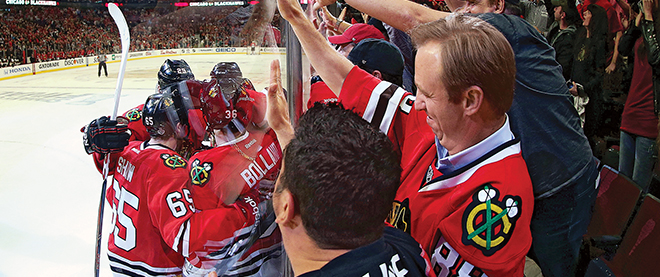The NHL’s come-from-behind win
How the National Hockey League turned a lockout-shortened season into a money-making success story
Bruce Bennett/Getty Images
Share

A funny thing has been happening this spring in Albuquerque, N.M., and Oklahoma City. Raleigh, N.C., and Milwaukee, too. Not to mention Los Angeles, Pittsburgh, Chicago and Boston. More people have been tuning in to watch the NHL playoffs than Major League Baseball. Fuelled by dream match-ups in the Conference Finals—and now an Original Six Stanley Cup—hockey’s U.S. TV audiences are more than double what they were a year ago, and are crushing the competition in the 18-49 age demographic advertisers clamour for.
But the good news isn’t just confined to the living room. In the lockout-shortened season that launched Jan. 19—48 games instead of 82—the league’s rinks played to 97.4 per cent capacity, and have been sold out for the playoffs. Revenues have bounced back, too. And while the league won’t equal the record $3.3 billion its 30 clubs earned in 2011-12, the final take will be better than the owners had the right to expect: something close to 70 or 75 per cent of last year’s gross, despite playing just 58 per cent of the games, with a return to healthy growth projected for next year.
It all raises the question: What happened to all the anger? Confronted with a third lockout in 18 years and deprived of hockey for 113 days, many fans vowed to take it out on both the owners and the players by staying home, turning off their sets and even boycotting sponsors. Yet as soon as the puck dropped, they returned in droves. “We have great fans. There’s no doubt about that,” NHL commissioner Gary Bettman said last week when pressed to explain—ones who are now accustomed to labour conflicts in pro sports. “The ultimate resolution of those [disputes] is what determines how the fans come back. If they’re comfortable that you’ve come to a place that makes the game healthy and stable going forward, they tend to be more forgiving.”
After the 2004-05 lockout, when the NHL became the first—and so far only—major sport to cancel an entire season, a lot of effort was put into reinventing hockey’s brand. There were focus groups, new ads, a redesigned logo and a rejigged game on the ice, with a crackdown on holding and the introduction of the shootout. This time around, however, the only apparent rebooting strategy was to keep Bettman and the league out of the headlines. Other than the odd good-news announcement—an anti-homophobia initiative with You Can Play; more outdoor games for next season—NHL headquarters resolutely left the spotlight on the home teams and players.
“It’s uncanny how well the NHL has bounced back,” says Ed O’Hara, senior partner with SME Inc., a Manhattan branding firm that worked with the league after the 2004-05 dispute. Blessed with perhaps the most tribal fan base in sports—many follow only hockey, and really care about just one team—and already on a path sponsors and advertisers like, there was little that needed to be done this time, he says. “Once fans saw a couple of games, I think they got amnesia. Hockey is just this drug they love.”
It’s been a similar story on this side of the border, as well. When the CBC’s Hockey Night in Canada returned in January with a Leafs-Habs match-up, it drew its largest-ever regular-season audience, with 27 per cent of the country tuning in for at least part of the game. Overall, ratings for the Saturday-night double-headers were up nine per cent for Game 1, and seven per cent for the second game. And through three rounds, the audiences for this year’s playoffs have been substantially up (17 per cent for the opening round, nine per cent for Round 2 and 61 per cent for the conference finals.) “People still wanted hockey,” says Trevor Pilling, CBC Sports’ head of programming. “The hunger for the game is evident in the numbers.”
So, too, with sponsors. Heading into the lockout, the NHL had long-term deals in all the major categories for both the U.S. and Canada. (Those fees, like the $180 million NBC paid for the U.S. TV rights this season, whether or not any games were played, go a long way to explaining the league’s still-healthy bottom line.) And just last week, Labatt Brewing Co., which lost out on the beer sponsorship last year—sparking a nasty legal fight with the NHL and Molson—announced a partnership making Budweiser the official beer of the NHL Players’ Association. A back-door play, acknowledges Jonathan Ritter, Labatt’s manager of media sports and entertainment, but a good one. “An association with hockey is critical for Canada. It’s a passion point.”
It’s all looking like yet another win for Bettman and his bosses. First, a new labour deal that will put an extra $2 to $3 billion in their pockets over the next decade. Now, a Chicago-Boston final that’s not only popular with fans, but rewards Rocky Wirtz and Jeremy Jacobs, two of the most hardline owners in the league. Proof positive that time heals all wounds. But it clearly doesn’t wound all heels.